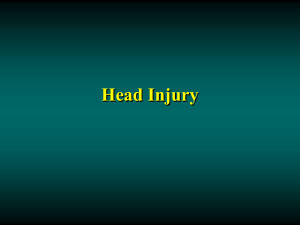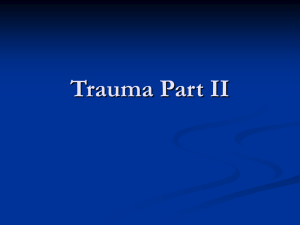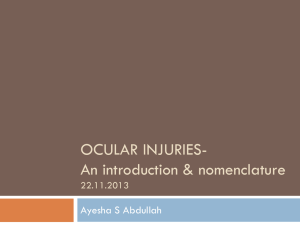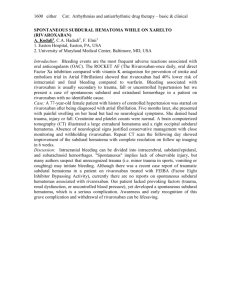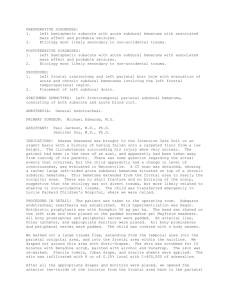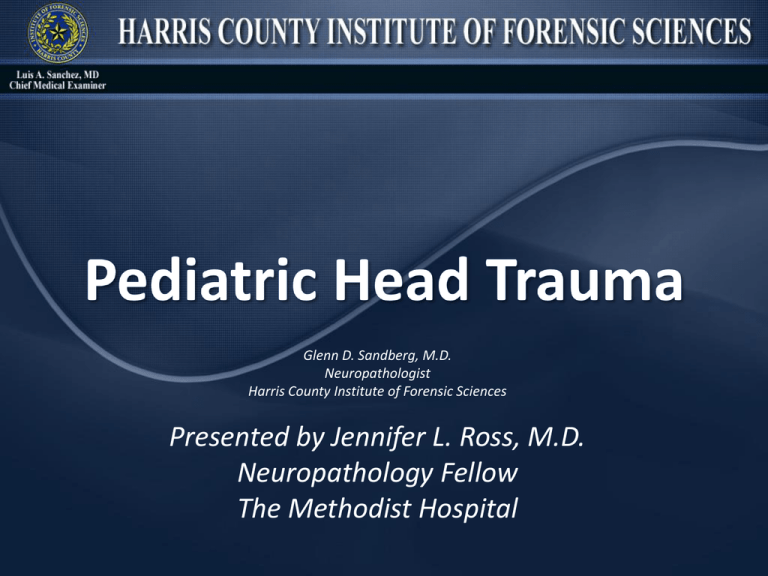
Glenn D. Sandberg, M.D.
Neuropathologist
Harris County Institute of Forensic Sciences
Presented by Jennifer L. Ross, M.D.
Neuropathology Fellow
The Methodist Hospital
Objectives
• Review the epidemiology of pediatric head
trauma
• Provide an introduction to major subtypes of
head injuries observed in pediatric head
trauma
• Show examples of typical head injuries
• Discuss challenges specific to the investigation
of fatal, non-accidental pediatric head trauma
Pediatric Head Trauma
• 80% of all significant head injury under the
age of 2 years is due to abuse
• 75-80% of child abuse fatalities are due to
head injury
• Majority are infants <1 year
• Percentage of deaths due to head trauma
decreases with age as abdominal trauma
becomes more prevalent
Sequelae of Head Injury
• 7-30% of children with abusive head injuries
die
• 30-50% live, but have significant cognitive or
neurological deficits
– Mental retardation, learning disabilities, seizures,
and blindness
• 30% recover
Types of Head Injuries
• Focal injuries
– Epidural hematomas
– Subdural hematomas
– Subarachnoid hemorrhages
– Contusions
– Parenchymal hemorrhages
• Diffuse injuries
– Axonal
• Traumatic
– Concussion
• Vascular
– Vascular
Epidural Hematoma
• Bleeding between skull and dura
• Occurs in approximately 2% of head injury
– 5-15% of fatal head injuries
• Almost always associated with skull fracture
– Usually thin squamous portion of temporal bone
• May occur in children without fracture
– Laceration of arteries or veins
– Middle meningeal artery-up to 50%
– Middle meningeal veins-30%
Epidural Hematoma
• Clinical
– Classical lucid interval sequence
• Features:
– Brief period of unconsciousness after injury
– Conscious, lucid interval of variable duration
– Coma
• Occurs in 13-43% of EDH
– Might be no more frequent in EDH than SDH
EPIDURAL HEMATOMA
Trauma -> fracture &
concussion
Tearing/stripping of dura away
from inner table
Laceration of meningeal
vessels
Blood between naked bone
and dura
NORMAL arterial pressure
continues to dissect
Epidural Hematoma
• Blood cannot cross
suture lines
– Often causes significant
mass effect
• Acutely can tolerate up to
40 mL
– Rarely survive if > 150 mL
Subdural Hematoma
• Accumulation of blood between dura and
brain
– Blood free to diffuse throughout subdural space
• Evident in ~95% of abusive head trauma
• May be small (<5 ml), bilateral and noncompressive
• May be associated with skull fracture
• May be present in open or closed head injury
Subdural Hematoma
• Commonly occur in
– Falls
72%
– Assaults
– MVA: 24%
– Child abuse
– Sports
Subdural Hematoma
• Result of torn bridging veins
– Some are secondary to ruptured
cortical arteries
• Sudden, rapidly applied angular
acceleration/deceleration of the
moveable head
– High strain stretches and snaps
bridging veins
• Span between cerebral
hemispheres and superior
sagittal sinus
• Subdural portions have a thin,
irregular collagenous wall
• Subarachnoid portions are
covered by arachnoid
trabeculae
Subdural Hematoma
• Characteristically form over the frontoparietal
regions
– Bilateral
• Adults: 18.5%
• Children: 76.7%
• Posterior fossa
– Rare: <1 %
– Particularly rare in a neonate
– Fracture to occiput present in 20-80%
• Spinal cord
– Rare; usually not compressive
Subdural Hematoma
• Gross:
– Loosely adherent dark red blood: 3-5 days.
– Well-formed outer membrane: 1 week.
– Well-formed inner membrane: 3-4 weeks.
Subdural Hematoma
• Associated findings
– 25% who undergo removal of acute subdural have
underlying cerebral edema
• >80% of these patients die
– Ischemia
• May be due to local compression of the microcirculation
or effects of vasoactive substances released from the
SDH
– Excitotoxic neuronal injury
Subarachnoid Hemorrhage
• Trauma most frequent cause
– Associated with contusions and lacerations
• Fatal traumatic SAH should be suspected in
– Ear injuries
– Parotid region injuries
– Upper neck injuries
Contusion
• “Bruise” of cerebral cortex
• Focal type of brain injury occurring at the
moment of impact
– Caused primarily by the surface of the brain
striking the skull or being impacted by it
• Overlying dura usually remains intact
• Injury patterns differ whether head is
stationary or in motion at moment of impact
– Freely mobile head motionless at impact
• Coup injury
– Freely mobile head accelerated in a fall prior
to impact
• Contrecoup injury
Contusion
• Do not occur in infancy
– Contusional tears
•
•
•
•
Tears at cortex-white matter junction
Occur before 6 months of age
Especially in frontal and temporal lobes
Not usually hemorrhagic
Contusion
• Gliding
– Head is in motion at the time
of impact
– Hematoma confined to the
parasagittal white matter of
the frontal lobes
• Each hemisphere is firmly
tethered to dura by arachnoid
granulations
• Subcortical white matter glides
more than cortex
– Deep basal ganglia
hematomas and DAI often
present
• Forces sufficient to cause both
axonal and vascular damage
Contusion
• Fracture
– Occur at site of fracture,
related to displaced bone
against cortex, may not be
at site of impact
Contusion
• Patients usually make
good recovery
– In absence of DAI
• Remote contusion
– Common incidental
finding at autopsy
– Cavitary lesion
– Destruction involving
full thickness of cortex
– Hemosiderin deposition
Diffuse Primary Head Injuries
• Diffuse injuries
– Concussion
– Diffuse axonal injury
Concussion
• Temporary, reversible neurological deficit
caused by trauma
– Velocity r necessary
• Consciousness can be retained in crush injury of fixed
head
• Results in immediate temporary loss of
consciousness
• Both retrograde and post-traumatic amnesia
always accompanies concussion
– Length of amnesia is indicative of severity of
concussion
Diffuse Axonal Injury
• First recognized as an essential component of posttraumatic dementia in 1956 by Strich
• Caused by inertial forces
– Angular or rotational acceleration
• Produced by long acceleration loading
– Common in MVA
• Falls have shorter acceleration loading
– Injury attributed to shear and tensile strains
• Occurs at moment of injury
• Do not experience lucid interval in severe cases
• Most common cause of coma and severe disability in
absence of intracranial hemorrhage
Diffuse Axonal Injury
• Occurred in:
– 34% of all fatal head injuries
– 53% of deaths that occurred after at least 12 hour
survival
• For equivalent levels of angular acceleration
– Lateral most severe
– Sagittal best tolerated
– Horizontal intermediate
Diffuse Axonal Injury
• Low incidence of:
– Surface contusions
– Skull fracture
– Intracranial hemorrhages
– Increased ICP
• Increased incidence of:
– Gliding contusions
– Deep intracerebral hematomas
Diffuse Axonal Injury
• Location
– Corpus callosum
– Cerebral lobar white matter
– Dorsolateral quadrant of rostral brainstem
adjacent to the superior cerebellar peduncles
– “Shearing injury triad”
Diffuse Axonal Injury
• Primary axotomy
– Rare
• Secondary axotomy
– Calcium hypothesis
• Physical stretch of axon
– Disrupts axons ability to regulate ions
• Influx of Ca2+ , K +,& Cl –
• Activation of neutral proteases
• Disruption of axonal cytoarchitecture
– Mechanical disruption
• Neurofilament subunits disrupted
• Axonal transport impaired
Axonal Spheroids
• H&E
– Need at least 18-24 hour survival
• BAPP
– Need at least 2-4 hour survival
Retinal Hemorrhages
• 80% of inflicted head trauma
– Multifocal
– Involve multiple retinal layers
– Extend to the ora serrata
– Optic nerve sheath hemorrhage is frequent
Causes of Retinal Hemorrhages
•
•
•
•
•
•
Severe head injuries (not limited to abuse)
Birth trauma - 30% are resolved by 1 month
Bleeding disorders
Sepsis
Vasculopathies
Sudden changes in intracranial pressure
– Terson’s syndrome
• CPR – Rarely
• Purtscher’s retinopathy-head or chest
trauma
Pediatric Head Trauma
• “Lucid interval” concept
– Vast majority of children who sustain fatal
head trauma show an immediate decrease in
consciousness (i.e. no lucid interval)
– An infant or young child who has sustained an
ultimately fatal head injury is not likely to act
normally
– Has important implications in criminal
investigation of cases of fatal inflicted blunt
head trauma
Shaken Baby Syndrome (SBS)
• Caffey, 1972
• Retinal, subdural, and/or subarachnoid
hemorrhages caused by violent shaking
– Whiplash action of head associated with weak
neck muscles resulting in accelerationdeceleration injuries
– Immature, partial membranous skull
– Relatively large subarachnoid space
– Soft, immature brain
Shaken Baby Syndrome (SBS)
• Controversies
– SBS injuries (retinal, subdural, subarachnoid
hemorrhage) can also be seen in impact head
injury
– Impact site may not be recognized by treating
physicians
– Even if no impact site is identified at autopsy,
the possibility of impact against a broad,
superficially soft surface cannot be excluded
– In addition, the specificity of retinal
hemorrhages for abuse has been questioned
– Conflicting research models
Shaken Baby Syndrome (SBS)
• Diagnosis of SBS should not be made when
evidence of direct impact is present
• Most cases of fatal head injury have evidence of
direct impact (facial or scalp contusions, skull
fractures)
• Even without identifiable impact site, impact
cannot be ruled out
• Therefore, SBS is rarely listed as a cause of death
Infant Death Investigation
•
•
•
•
•
•
•
•
•
Age, date of birth, birth weight, race, sex
Normal delivery vs C-section; any complications
Last known alive - by whom, date, time
Found dead - by whom, date, time
Place of death - crib, bed, floor
Position of infant when found - supine, prone
Resuscitation - method and by whom
Recent injuries/illnesses and medical history
Change in behavior or appearance; last time child
was behaving “normally”
• Prior infant deaths in the family
Investigative Challenges
•
•
•
•
Caregivers are often perpetrators
Reliable witness accounts are often lacking
Confessions may be unreliable
Determining mechanism of injury from autopsy
findings alone may be impossible
• Estimating age of injuries may be critical, but is
unreliable and further complicated by medical
treatment and hospital survival
Investigation – Red Flags
• Reported history is inconsistent with
physical findings
– Injuries that occur during the course of normal
daily activities (including playing and short
falls) do not usually result in fatal injuries
• Delay in seeking treatment
• Prior history of child abuse in household

